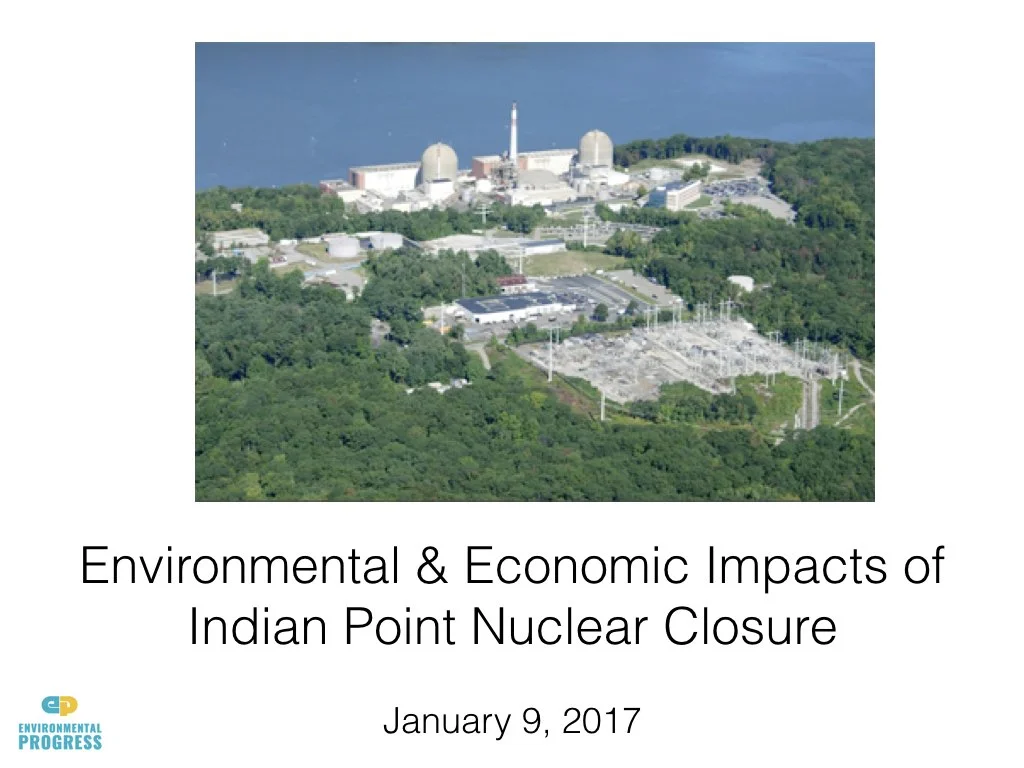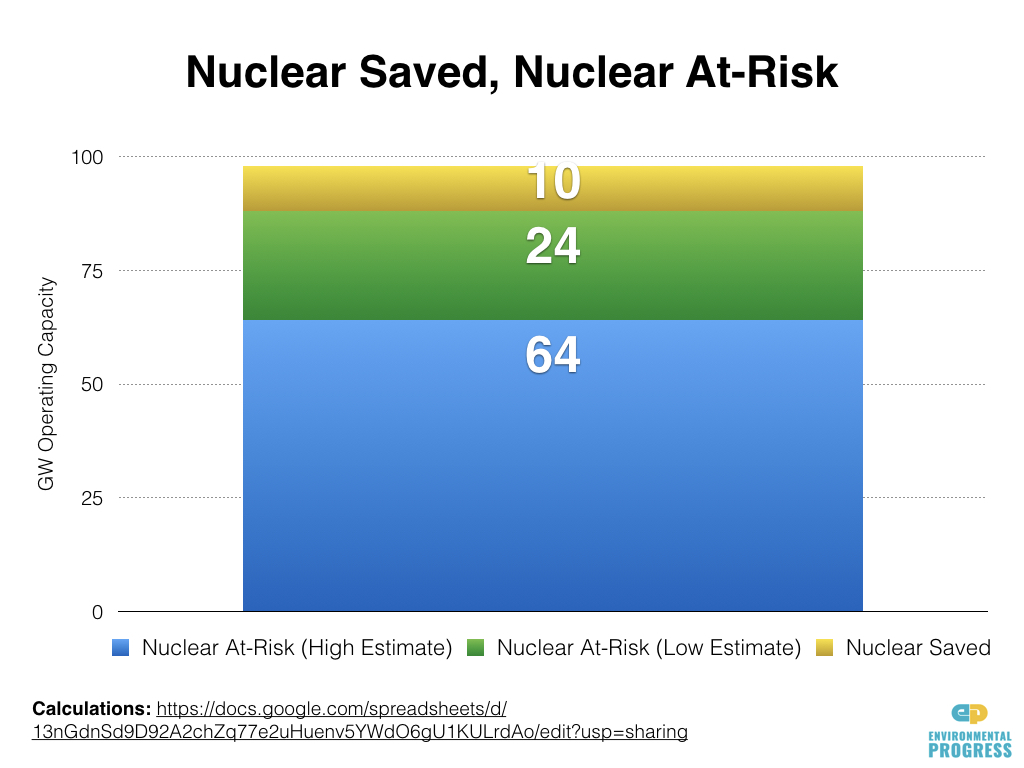In the early 1970s, Ohio started building nuclear plants to reduce air pollution from coal. But anti-nuclear activists including the Sierra Club and Ralph Nader decided they knew what was best for the people of Ohio, and blocked their construction. The result? The building of yet more coal plants, and thousands of premature deaths.
Now, 40 years later, anti-nuclear groups are trying to finish what they started.
In 2016, pro-nuclear advocates won our first victories against the anti-nuclear Goliath, saving nuclear plants from closure around the world.
But the anti-nuclear establishment quickly struck back with a series of victories resulting in announced nuclear plant closures and cancellations.
Now, in the wake of a financial crisis resulting from construction delays and cost overruns at two U.S. nuclear plants, the American nuclear giant Westinghouse has announced it might go bankrupt.
These are dark times for pro-nuclear forces, but we are starting to see pinpoints of light. Pro-nuclear rebels are finding their courage, from California to Taiwan to Australia to Germany.
In three weeks many of us will meet for the first time, and learn about each other’s struggles. We will find ways to help each other in ways we can’t currently imagine.
We will discover that what we are seeking is truly universal — and beautiful: a world of nature and prosperity for all
Read MoreThe looming insolvency of Toshiba has set off a chain reaction of events that now threatens the existence of nuclear power in the West.
The Japanese and French governments will be compelled to act for economic reasons — their nuclear industries are too important to their economies to fail.
Even though it lacks its own nuclear industry, Britain is emerging as the strongest of the three nations because it has a significant number of planned nuclear plants that involve Japanese and French companies.
The new conservative government of Theresa May has expressed more interest in industrial policy than prior conservative governments, and has already begun talks with the Japanese government about the UK government coming in as an investor on two of its planned plants.
The question is whether anyone in the three governments will have the vision and strength to make the right choices. The right choices will be the most difficult ones because they will require standing up first to the nuclear industry and next to ideologues on the Left and the Right.
But crises bring opportunities and there are large ones for reformers within the industry and within governments to do what should have been done 40 years ago: standardize designs, reorganize and consolidate the industry, and implement a vision to scale up plants while bringing down costs.
They can take inspiration from the success of Boeing, and the courage of Sully.
Read MoreToshiba, the venerable 80-year old Japanese electronics giant, appears to have gone bankrupt. Toshiba's losses stem from its construction of new nuclear plants in the United States.
Korea is winning the global competition to cheaply build new nuclear plants despite — or perhaps because of — being new to the game, and a small player compared to Russia, China, the US, France and Japan.
Korea has done so through focus: standard design, standard construction of plants, standard operation and standard regulation. Korea's nuclear plants are plug-and-play.
What does it mean for nuclear? What does it mean for the West?
Read MoreGerman electricity was nearly 10 times dirtier than France's in 2016, according to a new Environmental Progress analysis.
In 2016, Germany generated 545 terawatt-hours (TWh) of electricity at an average rate of approximately 560 grams of carbon dioxide emitted per kWh. By contrast, France generated 530 TWh of electricity at an average rate of approximately 58 grams of carbon dioxide emitted per kWh.
The analysis is based on hourly generation data from Franhofer ISE (Germany) and RTE (France), as of February 6, 2017. Conversion of German generation data to Specific Carbon Intensity uses emissions factors of 1150g, 900g, 369 g, and 983 g of CO2 per KWh for lignite (brown coal), hard coal, natural gas, and biomass respectively. Conversion of French generation data to Specific Carbon Intensity Uses RTE-France's emissions factors.
Read MoreCalifornia’s power sector emissions are two-and-a-half times higher today than they would have been had the state kept open and built planned nuclear plants, a new Environmental Progress (EP) analysis finds.
In the 1960s and 1970s, California’s electric utilities had planned to build a string of new reactors and new plants that were ultimately killed by anti-nuclear leaders and groups, including Governor Jerry Brown, the Sierra Club and Natural Resources Defense Fund (NRDC).
Other nuclear plants were forced to close prematurely, including Rancho Seco and San Onofre Nuclear Generation Station, while Diablo Canyon is being forced to close by California's Renewable Portfolio Standard, which excludes nuclear.
Had those plants been constructed and stayed open, 73 percent of power produced in California would be from clean (very low-carbon) energy sources as opposed to just 34 percent. Of that clean power, 48 percent would have been from nuclear rather than 9 percent.
Read MoreGerman emissions increased in 2016 for a second year in a row as a result of the country closing one of its nuclear plants and replacing it with coal and natural gas, a new Environmental Progress analysis and investigation finds.
Not only did new solar and wind not make up for the lost nuclear, the percentage of time during 2016 that solar and wind produced electricity declined dramatically.
Germany added a whopping 10 percent more wind turbines and 2.5 percent more solar panels between 2015 and 2016, but generated less than one percent more electricity from wind and generated one percent less electricity from solar.
As such, 2016 is a dramatic illustration of the inherent limits to sources of electricity that are precisely as reliable as the weather.
Emissions would have declined had it not closed a nuclear plant and replaced it with coal and natural gas.
Read MoreIf New York Gov. Andrew Cuomo succeeds in his effort to close Indian Point nuclear power plant, carbon emissions will spike and the state will become more dependent on fossil fuels than it has been since 2000, a new Environmental Progress (EP) analysis finds. EP finds:
- New York's dependence on fossil fuels will rise from 44 percent to 56 percent of its electricity mix;
- New York will lose 23 percent of its clean power;
- Power sector carbon emissions will skyrocket 29 percent, from 31 to 40 million metric tons;
- Twice as many emissions will be added as are required to be reduced under EPA's Clean Power Plan.
The New York natural gas promotor under federal prosecution for bribes to Governor Andrew Cuomo's top aide pushed to close Indian Point nuclear plant, according to the U.S. Attorney's September 22, 2016 indictment.
"Based on my review of publicly available documents and my interviews of witnesses," wrote the US attorney, "including employees of [Competitive Power Ventures], the importance of the [CPV Valley Energy Center] to the State depended at least in part, on whether [Indian Point] was going to be shut down."
Read MoreAround this time last year, I founded a new organization with a big ambition and a simple strategy: protect and expand access to cheap and clean power, a critical driver of environmental progress.
I'm writing now to reflect back on an extraordinary year, give you a peek into what's coming in 2017, and invite you to become a founding member of Environmental Progress.
Here's a look back at the year.
Read MoreOne-quarter to two-thirds of all U.S. nuclear plant reactors are at-risk of being closed prematurely, according to a new analysis by Environmental Progress. If half are closed and replaced with natural gas, the additional carbon emissions would be the equivalent of adding roughly 50 million cars to the road.
But 20 percent fewer nuclear reactors are at risk of closure now than at the beginning of 2016 thanks to policies implemented by New York and Illinois governments to recognize the environmental value of nuclear energy
Read MoreI am very happy to announce the publication of an open letter to President-elect Donald Trump and Governor Rick Perry, urging them to unite Americans and the world around an inspiring new vision: making nuclear great again. Co-authors include climate scientists, climate skeptics, and scholars from American Enterprise Institute and Brookings Institution. At a time when America is more divided than ever, nuclear stands out in its ability to unites liberals, conservatives and a growing number of environmentalists.
Read MoreCalifornia already suffers from "single-fuel dependency" that could increase the state's vulnerabilities during "extreme weather conditions," says the association of electric grid operators in a new report.
"Natural-gas-fired generation comprises 68 percent of on-peak anticipated capacity [in California] by 2021," the National Electric Reliability Council (NERC) notes.
And that high level of dependence on natural gas would increase if California closes its last nuclear power plant, Diablo Canyon, in 2024/25.
Already, California gets 66 percent of its in-state electricity from natural gas — an amount that rose from 58 percent in 2011, and could rise to 74 percent if Diablo Canyon is closed.
Read MoreOur statement on big Illinois victory:
"The Illinois victory shows that while we still have a long way to go toward protecting and expanding nuclear. Nobody has a realistic vision for expanding rather than merely maintaining nuclear energy.
The US could lose half of our reactors in the next 13 years, and yet many of the institutions that should be fighting the hardest to save nuclear plants are doing remarkably little.
The lesson from Illinois is that for the situation to change, the key institutions — both pro-nuclear and anti-nuclear — must change first."
Read More“It’s sad to see the effort by Food and Water Watch to close New York’s largest source of clean power, nuclear energy. If their efforts succeed, they will increase fossil fuel burning, pollution, asthma, and premature deaths. With its campaign, Food and Water Watch has established itself as the most anti-environmental of all of the anti-nuclear groups operating in New York state. Thank goodness Governor Cuomo is exhibiting good common sense on this matter.”
Read MoreWhen PG&E announced the deal it had secretly negotiated with anti-nuclear groups to close Diablo Canyon, California's last nuclear plant, it claimed rates would not rise. NRDC, one of the parties to the proposal, went further, claiming "PG&E customers will save at least a billion dollars by replacing Diablo Canyon."
Now, PG&E admits that the closure would cost $1.8 billion, and that rates would rise immediately after if gets approval from the state's Public Utilities Commission.
Hours after the deal was announced on June 21, Environmental Progress was the first to point out that "The proposal would increase electricity rates," in a statement, as well as on a conference call and in conversations with reporters.
There's no point in sugar-coating what happened. PG&E and NRDC deliberately lied to the public and the media.
Read MoreGiven Kari's line of questioning, I finally asked her who funds her work.
Kari said there was a "fire wall" between her reporting and the corporate donations.
After she emailed me again last night, asking about my donors, I got so fed up that I decided to do some digging.
Would you be shocked to learn her employer, Midwest Energy News, which is run by Fresh Energy, takes money from both fossil and renewable energy companies?
I interviewed her about all of this today.
I think Kari means well, but there are some troubling findings here — findings I only inadvertently discovered because of her lack of awareness of the double standard she is prosecuting against those she disagrees with.
Read MoreSan Francisco, California — Legendary climate scientist James Hansen will join Assembly Member Mike Gatto to call for reforms of California’s Public Utilities Commission (PUC) after it meets today.
"What's up with Governor Brown?” asked Hansen. “He killed reform legislation that require the same transparency as other state agencies, and allow appeals to the regular court, not the corrupt PUC courts. Something is rotten about energy policy in Sacramento — and the losers are ratepayers and young people."
Gatto has said he will continue to fight for reforms and says he will seek a ballot initiative if the legislature fails to act. “The fight for CPUC reform is not over, and I remain committed to continuing the efforts that are sorely needed to bring transparency to the process, help keep rates low, and ensure the safety of Californians,” said Gatto.
“The last time CPUC forced a nuclear plant to close the result was a federal criminal investigation, skyrocketing pollution and higher electricity rates,” said Environmental Progress founder, Michael Shellenberger. “Now CPUC is trying to do the same thing. No CPUC proceedings on Diablo Canyon should go forward without real reforms.”
Read More



















